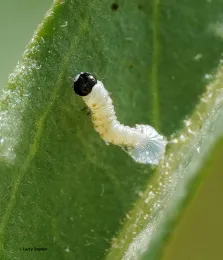UC Davis Research: What a Monarch-Milkweed Interaction Project in North Davis Revealed

“This study collected a high-resolution temporal dataset on milkweed-monarch interactions during the last three years prior to the precipitous single-year population decline of western monarchs in 2018,” said community ecologist Louie Yang, a professor in the Department of Entomology and Nematology.
Yang organized and led a 135-member team, all co-authors of the paper, “Different Factors Limit Early- and Late-Season Windows of Opportunity for Monarch Development,” published in the journal Ecology and Evolution. (This document is open access at https://bit.ly/3volFaI.)
From 2015 through 2017, the team monitored the interactions of monarchs, Danaus plexippus, on narrow-leaved milkweed, Asclepias fascicularis, planted in December 2013on city-owned property adjacent to the North Davis irrigation channel.
“This study has three key findings,” the UC Davis professor said. “First, we documented early and late seasonal windows of opportunity in the wild, migratory western monarch population. Second, our data suggest that early and late seasonal windows were constrained by different factors. Third, climatic and microclimatic variation had a strong effect on the timing and importance of multiple factors affecting monarch development. Broadly, we hope that this study contributes to a more temporally detailed understanding of the complex factors that contribute to year-to-year variation in monarch breeding success.”

Feared on its way to extinction, the migratory monarch is now on the International Union for Conservation of Nature (IUCN) Red List of Threatened Species as Endangered—threatened by habitat destruction and climate change. Statistics show that the overwintering population of western monarchs along coastal California has declined by more than 99 percent since the 1980s, according to the Xerces Society for Invertebrate Conservation.
The UC Davis-based team set out to answer three questions: (1) How do the developmental prospects of monarchs vary in time, within- and across years? (2) How do the combined effects of bottom-up, top-down, and abiotic factors interact with seasonal variation in monarch density to constrain the timing and extent of seasonal windows of opportunity? and (3) How do climatic variation and microhabitat heterogeneity affect these constraints?

The results showed that different combinations of factors constrained the early- and late-season windows of opportunity for monarch recruitment. “Early-season windows of opportunity were characterized by high egg densities and low survival on a select subset of host plants, consistent with the hypothesis that early-spring migrant female monarchs select earlier-emerging plants to balance a seasonal trade-off between increasing host plant quantity and decreasing host plant quality,” the abstract relates. “Late-season windows of opportunity were coincident with the initiation of host plant senescence, and caterpillar success was negatively correlated with heatwave exposure, consistent with the hypothesis that late-season windows were constrained by plant defense traits and thermal stress.”
The researchers also noted:
- “Throughout this study, climatic and microclimatic variations played a foundational role in the timing and success of monarch developmental windows by affecting bottom-up, top-down, and abiotic limitations. More exposed microclimates were associated with higher developmental success during cooler conditions, and more shaded microclimates were associated with higher developmental success during warmer conditions, suggesting that habitat heterogeneity could buffer the effects of climatic variation.”
- “Together, these findings show an important dimension of seasonal change in milkweed-monarch interactions and illustrate how different biotic and abiotic factors can limit the developmental success of monarchs across the breeding season. These results also suggest the potential for seasonal sequences of favorable or unfavorable conditions across the breeding range to strongly affect monarch population dynamics.”
Yang and his team planted 318 narrow-leaved milkweed adjacent to the seasonal irrigation channel, which carries runoff water with a “seasonal pattern of generally increased flow during summer irrigation periods and immediately following winter precipitation events. As a result, this site combines several elements representative of the California Central Valley at a landscape scale.” The Davis site typifies a “Mediterranean pattern of cool, wet winters and hot dry summers.”
The researchers recorded daily temperatures and precipitation in one dataset, and in a second dataset, sub-hourly temperature observations, approximately every 20 minutes. They defined the “early season” as days 90–180 (approximately the end of March to the end of June) and the late season as days 180–270 (approximately the end of June to the end of September) each year.”
They measured and recorded the milkweed growth and leaf area removal by herbivores, and counted and measured the eggs and larvae. They also gathered information on the predator and herbivore community.
MMMILC Project. Participants in the Monitoring Milkweed–Monarch Interactions for Learning and Conservation (MMMILC) Project, directed by Yang, collected most of the observations. Yang provided hands-on, in-person training in milkweed-monarch biology, data collection, and data entry protocols, partnering with the Environmental Science internship program led by Eric Bastin at Davis Senior High School and the Growing Green internship program led by Karen Swan at the Center for Land-based Learning, Woodland.
“We documented 674 weekly observations of monarch eggs and 997 weekly observations of monarch caterpillars across the three years of this study,” the researchers wrote. “Monarchs were most numerous in 2016. We observed 2.7 times as many monarch eggs in 2016 as in 2015 and 2.2 times as many as in 2017. We observed 3.0 times as many caterpillars in 2016 as in 2015, and 2.5 times as many as in 2017. Separated by year and normalized by the total number of emerged plants each year, we observed 137 eggs and 193 caterpillars (0.49 egg and 0.69 caterpillar observations per plant) in 2015, 369 eggs and 576 caterpillars (1.55 egg and 2.42 caterpillar observations per plant) in 2016 and 168 eggs and 226 caterpillars (0.74 egg and 1.0 caterpillar observations per plant) in 2017.
Among their research findings:
- The early and late monarch developmental periods were generally warmer in 2017 than in the two previous years.
- The number of surviving emerged plants declined over the 3-year study, from 281 (88.3 percent) in 2015, to 238 (75 percent) in 2016 to 226 (71 percent) in 2017. However, an increasing proportion of the surviving plants attained a total stem length exceeding 50 cm across these same years: 137 (49 percent of 281) in 2015, 144 (61 percent of 238) in 2016, and 175 (77 percent of 226).
- The growth of milkweeds changed dramatically in 2017 following the rainy winter of 2016–2017. Milkweeds in 2017 attained sizes (maximum weekly mean total stem lengths) that were 70 percent larger than in 2015, and 64 percent larger than in 2016, and the variance of the plant size distribution also increased.
- Milkweed emerged earliest in 2016 (mean emergence day 110) and nearly four weeks later in 2017 (mean emergence day 137).
Unfortunately, a City of Davis maintenance crew unintentionally mowed the site on May 5, 2017, “damaging several plants in this population. However, most plants in the population were below the height of the mower blades at this point in the growing season.”
Today the milkweed population at the North Davis Channel is being maintained by the City of Davis and dedicated citizens, including Larry Snyder, who documented the project in photographs. “We aren't monitoring there intensively, but we've seen monarch eggs, caterpillars and adults there this year,” Yang said.
More monarch projects from the Louie Yang lab are pending. “The next paper in press represents research done several years ago and is focused on the timing of herbivory and its effects on flowering,” he said. “We are studying several California milkweed species.”
